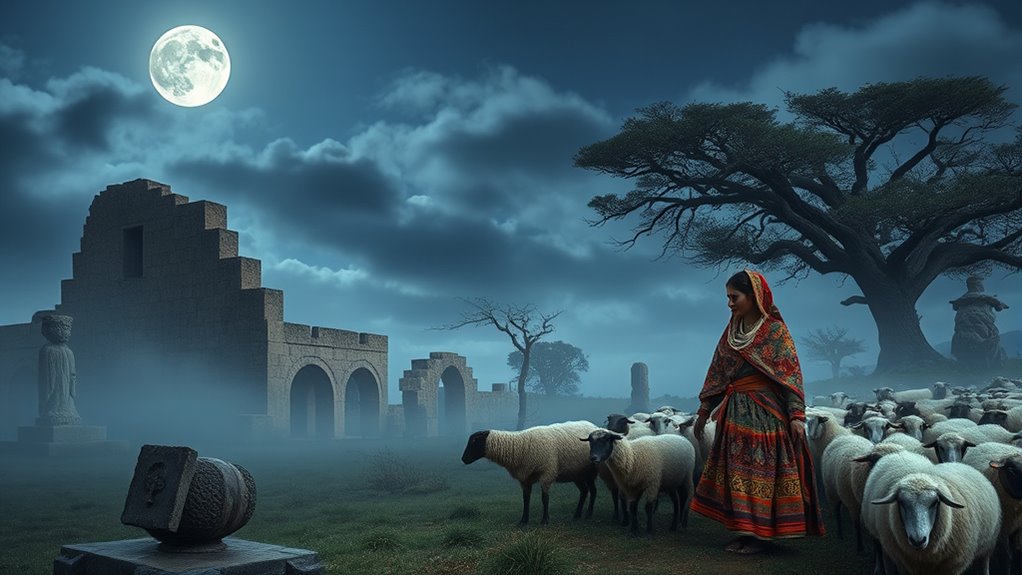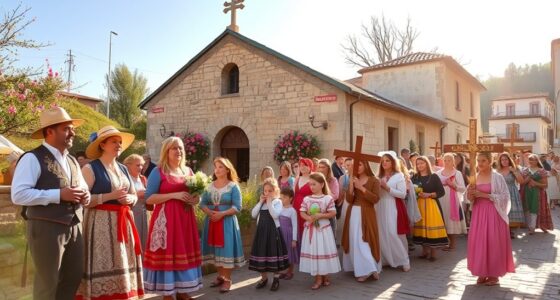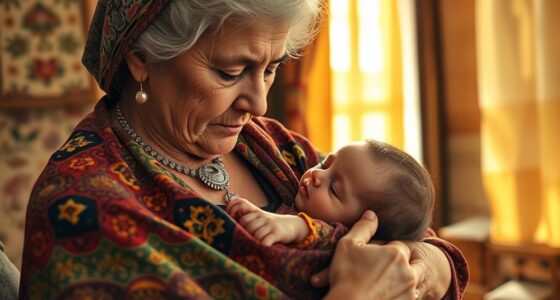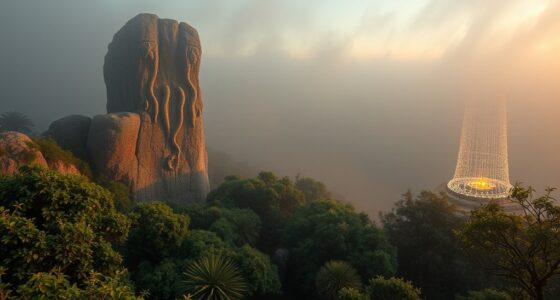Sardinian folklore and myths are full of magical creatures, sacred sites, and stories that reflect the island’s rich history. You’ll find tiny fairies called Janas, fierce water spirits, and legendary giants, along with mystical locations like Sella del Diavolo and Su Sterru cave. These tales reveal themes of protection, transformation, and morality rooted in ancient traditions. Keep exploring to uncover the fascinating legends and cultural symbols that continue to shape Sardinian identity.
Key Takeaways
- Sardinian folklore features mythical beings like Janas, Erchitu, and Su Scultone, embodying morality, protection, and natural forces.
- Legendary locations such as Sella del Diavolo and Su Sterru are linked to myths involving divine battles and supernatural events.
- Common themes include supernatural creatures, symbols of fertility, transformation, and the connection between nature and morality.
- Folklore is rooted in ancient Nuragic, Phoenician, and Greco-Roman influences, transmitted through oral traditions and community storytelling.
- Modern cultural practices, festivals, and artwork preserve and celebrate Sardinian legends, reinforcing local identity and heritage.
Legendary Creatures and Beings of Sardinia
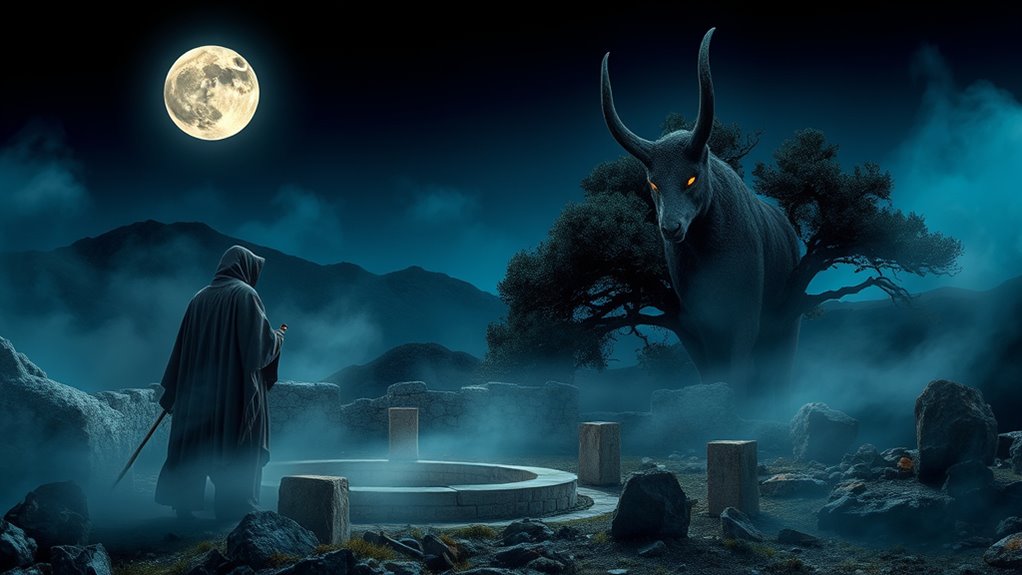
In Sardinian folklore, legendary creatures and beings embody the island’s rich tapestry of myths, warning tales, and moral lessons. You might hear about the Janas, tiny fairy-like beings about 25 centimeters tall, living in ancient rock-cut tombs. They’re seen as helpers to the honest but punishers of greed, with their nature shifting between kind and mischievous depending on mood. The Erchitu appears as a white ox with large horns on full moon nights, signaling impending death for a wrongdoer. The Erchitu is considered a symbol of death and transformation in Sardinian culture. Su Scultone, a dragon-like creature with fiery breath, guards hidden treasures deep within caves. The wild boar, Su Sirboni della Zerrara, is said to protect riches beneath the forest canopy. These beings reflect Sardinia’s deep connection to nature, morality, and the supernatural, and are often linked to local legends that serve to preserve moral values and cultural identity.
Mystical Locations and Their Stories

Sardinia’s landscapes are woven with stories that blend natural beauty and supernatural mystery, inviting you to explore their legendary origins. The Sella del Diavolo, a striking rock formation near Cagliari, is linked to a myth where Lucifer tried to claim the land for himself. A divine battle ensued, ending in Lucifer’s defeat and the creation of the Angels’ Gulf, symbolizing celestial victory. In Baunei, the legend of St. Peter tells of him opening the earth to trap a basilisk in Su Sterru, saving the villagers. The rugged caves of Su Scultone are said to harbor a dragon guarding treasures, while Monte Arcosu’s haunted bride symbolizes eternal love and betrayal. Near Alghero, Argentiera’s haunted tunnels and Lake Baratz’s submerged village deepen the region’s mystical allure, blending history with legend. Monte Prama Giants, representing ancient warriors, are connected to legends of a gigantic pre-human population that once inhabited Sardinia, adding to the island’s mythic landscape. Additionally, the cultural heritage of Sardinia plays a vital role in preserving and transmitting these stories through generations, enriching the island’s mystical identity.
Common Themes and Symbols in Sardinian Tales
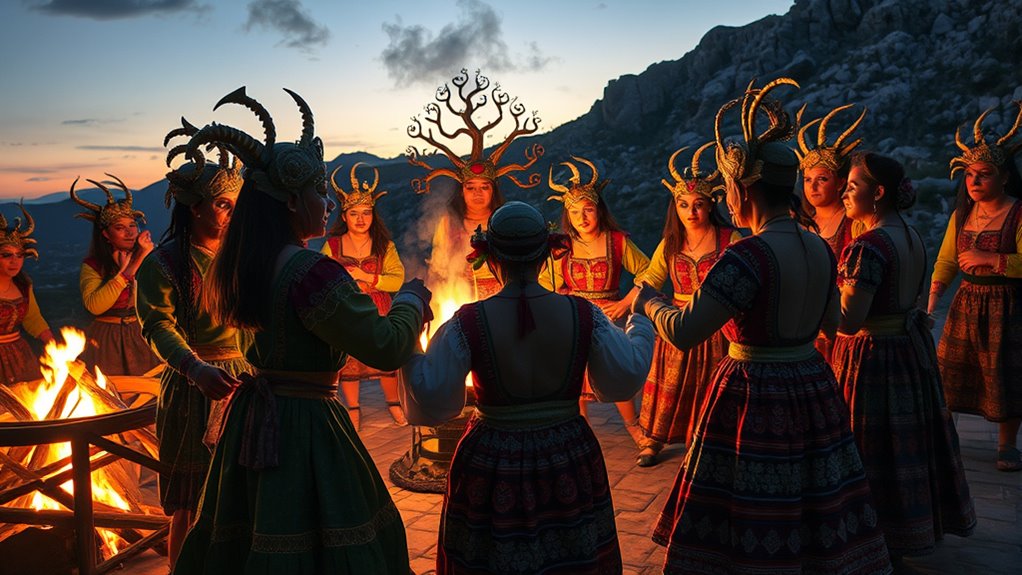
Many Sardinian tales revolve around supernatural beings and mythical creatures that embody the island’s deep connection to nature and tradition. These symbols highlight themes of fertility, protection, and transformation. You might imagine fairies called Janas guarding ancestral tombs, representing fate and fertility. Envision giants dwelling within ancient Nuraghe stones, symbolizing strength and natural forces. Witch-like Cogas wield dual powers to curse or heal, embodying magic’s ambivalent nature. Water spirits inhabiting wells remind you of the sacredness of natural sources, while heroic figures like Sardus represent resilience and bravery. Artifacts and ruins from ancient civilizations serve as tangible links to these legends, emphasizing nature’s influence, moral lessons, and the journey of personal and communal growth through adventure and change. Sardinian tales weave these themes into rich, meaningful stories rooted in the island’s cultural fabric. Additionally, the mythical symbolism often reflects the island’s landscape and environmental features, reinforcing the deep bond between nature and storytelling.
Origins and Transmission of Folklore
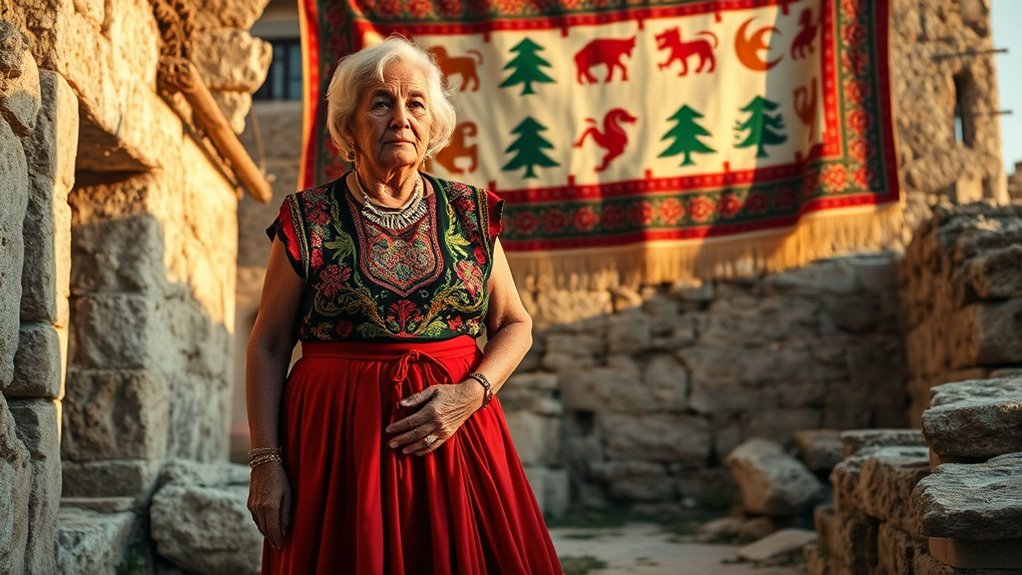
The origins of Sardinian folklore are deeply rooted in a complex history shaped by multiple ancient cultures. You can see this in the island’s earliest Nuragic civilization, whose nuraghes and steles form the mythic backbone of many stories. Later, Phoenician and Punic influences introduced new myths linked to Mediterranean trade and conflicts. Roman rule added Greco-Roman elements, blending hero cults like Sardus Pater with local identity. Folklore was mainly transmitted orally, often around family hearths or village gatherings called “contos de ‘foghile.” Stories passed from generation to generation, fostering community bonds and cultural preservation. Over time, these oral traditions were sometimes written down, but their roots remain in communal storytelling, deeply embedded in Sardinia’s regional identities and historical layers. Oral storytelling continues to be a vital way of preserving these legends today, ensuring their survival amid modern changes. Additionally, modern efforts to document and analyze these stories help keep this cultural heritage alive for future generations.
Cultural Significance and Modern Interpretations

Contemporary culture in Sardinia continues to thrive on the rich foundations of its folklore, which shape daily life and community identity. You see this in festivals, where reenactments, costumes, and mythological themes keep stories alive. Folktales still influence local traditions, reinforcing values like bravery, loyalty, and hard work. Families share these stories during gatherings, passing them to younger generations. Modern artists and writers draw inspiration from ancient myths, blending tradition with contemporary expression—think of murals depicting Nuraghe towers or novels featuring legendary creatures. Mythological figures like Janas and Giganti symbolize protection and community bonds. These stories and symbols remain crucial, helping Sardinians preserve their cultural legacy while adapting it to modern life, keeping folklore vibrant and relevant across generations. This continuity demonstrates how deeply rooted mythological symbols are in the Sardinian identity and how they serve as a bridge between past and present. Additionally, the preservation of cultural symbols fosters a sense of pride and belonging among the local population.
Frequently Asked Questions
How Do Sardinian Myths Influence Contemporary Local Festivals?
You see that myths shape how festivals unfold today. They inspire the themes, costumes, and rituals, making celebrations vivid and meaningful. By participating, you connect with ancestral stories and community identity. The myth-inspired dances, processions, and symbols reinforce shared history, creating a sense of belonging. These festivals also boost local economies through tourism, ensuring that the rich cultural heritage continues to thrive and evolve with each new generation.
Are There Specific Legends Associated With Sardinian Coastal Areas?
You’ll find that Sardinian coastal areas are rich with legends that bring their landscapes alive. For example, Sella del Diavolo’s rocky saddle is said to be Lucifer’s petrified saddle, and Angels’ Gulf honors the angels protecting the coast. You might also hear about Janas, tiny fairies inhabiting ancient tombs, or Saint Peter battling a monster in Baunei. These stories connect the land, sea, and local history in enthralling, mystical ways.
What Role Do Women Play in Sardinian Folklore Stories?
You see, women in Sardinian stories often serve as powerful figures embodying death, protection, and rebellion. From the accabadora, who helps end suffering, to the Filonzana, wielding the thread of life, women hold supernatural, moral, and social roles. They also challenge gender norms, like Donna Lucia, who defies traditional roles. These stories highlight women’s complex influence, blending nurturing, authority, and resistance, shaping Sardinian cultural identity.
How Have Sardinian Myths Evolved With Modern Technology?
Think of myths as ancient seeds, and technology as the nurturing rain that helps them grow anew. You see, modern tools like virtual reality and social media act as storytellers, transforming old tales into interactive experiences. By digitizing sites and sharing stories online, you expand their reach, blending tradition with innovation. Technology becomes a bridge, allowing you to explore and reinterpret myths, ensuring they thrive in the digital age.
Are There Unpublished or Secret Legends Still Kept by Local Communities?
You might wonder if secret legends still exist within local communities. It’s likely, as many stories are passed down orally, kept private, and shared only in small groups or family gatherings. These tales often involve supernatural beings, hidden treasures, or sacred sites, and are sometimes deliberately kept secret to protect cultural identity or traditions. Some stories may have faded over time, but others remain alive, guarded within community memory.
Conclusion
Exploring Sardinian folklore reveals a vibrant world of mythical creatures, mystical sites, and enduring symbols that shape its culture. You might think these stories are just old tales, but they create a vivid tapestry connecting past and present. Imagine standing at a sacred site, feeling the legends come alive around you. These myths aren’t just stories; they’re living parts of Sardinia’s identity, inviting you to see the island’s rich spirit through its timeless tales.
